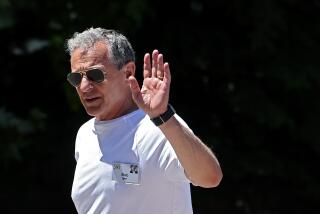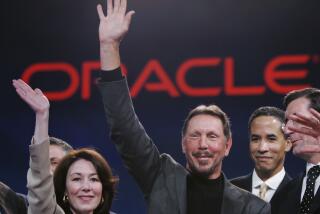With Iger charting the way, Disney sails on smooth seas
Few people would mistake Albuquerque as the happiest place on Earth.
But the city -- the setting (if not the actual filming location) for the fictional East High from one of Walt Disney Co.’s hottest franchises, “High School Musical” -- seemed an appropriate place for President and Chief Executive Robert Iger to tout the year’s accomplishments to shareholders.
The reserved yet affable Iger has plenty to celebrate. The annual return to shareholders over the last five years was 15.3% -- outperforming the annual average for the Standard & Poor’s 500. And despite worries about a slowing economy, Disney’s operating profit at its media networks, parks and resorts, and consumer product groups grew by double digits in its most recent quarter.
Creatively, it’s also on a roll. Disney walked away from the Academy Awards with the best picture honor for its Miramax Films’ “No Country for Old Men,” and a best animated feature nod to “Ratatouille.”
Billionaire investor Warren Buffett singled out Iger as one of the country’s best CEOs, noting in a CNBC interview Monday how he had done “an absolutely terrific job since coming in a couple years ago. It’s not an easy company to manage, and he’s done a first-class job.”
Iger credited the people around him, telling shareholders Thursday, “The success of our company rests, more than anything else, on the commitment of our 137,000 employees and cast members.”
When Iger succeeded Michael Eisner as chief executive in October 2005, after serving as Eisner’s No. 2 for five years, critics knocked him for lacking creative vision. Some faulted his role in overseeing the then-struggling ABC and saw him as damaged goods because of his close ties to Eisner, whom shareholders had rebuked with a 45% no-confidence vote in March 2004.
But Iger proved precisely the balm Disney needed after the tumultuous, autocratic final Eisner years. He immediately set to work repairing relationships, starting with Pixar Animation Studios Chairman Steve Jobs, who had broken off talks with the company after a bitter falling out with Eisner, and was actively courting other studio deals.
Investors say Disney’s $7.4- billion acquisition of Pixar in 2006 got Iger’s tenure off to a great start. It shored up Disney’s struggling animation division and assured that Pixar’s characters would continue to nourish Disney’s theme parks, consumer product division and home video business.
“I really do think animation is the key to so much of Disney’s success. It’s a critical piece,” said Janna Sampson, co-chief investment officer of OakBrook Investments near Chicago, which owns 260,000 Disney shares. “It’s something that as an investor, we give him thumbs up for.”
One of Iger’s first acts as CEO was to dismantle Eisner’s hated Strategic Planning Group, which was regarded internally as the place ideas went to die.
“By decentralizing the company’s decision-making process and eliminating the Strategic Planning Group, he has enormously improved morale throughout the company,” said Jack Liebau, president of investment management firm Liebau Asset Management Co. of Pasadena, who has followed Disney for 20 years.
That decision is paying creative dividends. It can be measured in the number of major creative franchises, which has blossomed from two to 10, Iger said during a recent earnings call with analysts. He told shareholders that creative content could be leveraged across Disney’s various businesses.
“Hannah Montana,” the Disney Channel series about a teen with a secret life as a pop star, led to a 3-D movie called “Hannah Montana/Miley Cyrus: Best of Both Worlds Concert Tour,” which has grossed more than $63 million to date. Disney Fairies, rooted in the 1953 animated film “Peter Pan,” has spawned more than 385 books about Tinker Bell and her friends in Pixie Hollow, a line of toys and jewelry, a coming online virtual world and an animated film to be released on DVD.
“He has found great people, many of which were there and not empowered, and many of which are new, and he has created an environment in which creativity is thriving,” said Jeffrey Katzenberg, chief executive of DreamWorks Animation and former head of Walt Disney Studios under its last animation renaissance. “The heritage of that company is creativity. It is back and flourishing as much as it’s ever done in its history.”
Iger credits his mentor, Thomas S. Murphy, founder of ABC’s former parent, CapCities, for a management style that emphasizes teamwork and collaboration. In a recent interview with Business Week, Iger said he learned that “you put good people in jobs and give them room to run.”
“Bob seems like the perfect person to lead Disney now,” said Comcast Corp. Chief Operating Officer Stephen B. Burke, who worked with Iger at ABC. “He is creative and a good businessman, but also is very likable, approachable and great at identifying talent.”
Peter Chernin, News Corp.’s president and chief operating officer, said Iger’s style helped put an end to the 100-day writers strike, which was resolved last month. The two studio executives were credited with breaking the impasse.
“The same skills that served the industry well during the writers strike are what has led to the resurgence of Disney,” Chernin said, describing those talents as “a great knowledge base of all aspects of the business, along with a very straightforward, productive attitude.”
--
More to Read
The biggest entertainment stories
Get our big stories about Hollywood, film, television, music, arts, culture and more right in your inbox as soon as they publish.
You may occasionally receive promotional content from the Los Angeles Times.










